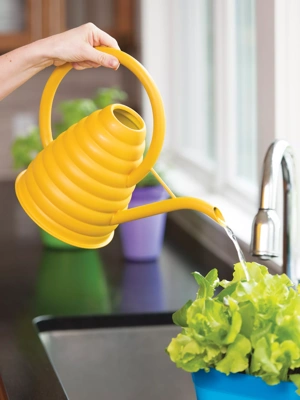Attracting Beneficial Bees
Gardeners can help counter the decline in pollinator populations
 Honeybee covered in pollen on on California poppy flower. Photo: Dawn Pedersen
Honeybee covered in pollen on on California poppy flower. Photo: Dawn Pedersen Most gardeners are familiar with the vital role bees and other pollinators play in a healthy and productive garden. But their importance touches our lives every day. Did you know that one out of every three bites of your food depends on a pollinator? That's because about 150 crops grown in the U.S. depend on pollinators, including apples, almonds, blueberries, citrus, melons, pears, plums, pumpkins and squash. Pollinators are also vital to plants fed to livestock, as well as to fiber-producing plants, such as cotton.
What is Pollination?
Simply put, pollination occurs when pollen is transferred from one flower to a second flower of the same species, where it can fertilize it and begin the process of fruit and seed production. Although some plants can pollinate themselves, most require the help of insects, birds, bats and other organisms — collectively referred to as pollinators.
Watch as a honeybee visits an apple blossom in search of nutritious nectar and pollen, and you may see some of the flower's pollen clinging to its fuzzy body. When that bee visits another flower, some of the pollen gets transferred. Good pollination results in large, healthy fruits with viable seeds. Poor pollination results in deformed fruits that often drop off before maturing.
 Bumblebees are much larger, plumper and fuzzier than honeybees.
Bumblebees are much larger, plumper and fuzzier than honeybees.Flowers that Bees Love
- Alyssum
- Agastache (anise hyssop)
- Asclepias (butterfly weed)
- Aster
- Echinacea (coneflower)
- Geranium (cranesbill)
- Monarda (bee balm)
- Papaver (poppies)
- Rudbeckia (black-eyed Susan)
- Trifolium (clover)
More information: Attracting Butterflies, Hummingbirds and Other Pollinators.
Pollinators in Peril
Bees are workhorse pollinators. In addition to the familiar honeybee, there are about 4,000 species of native or wild bees in the continental U.S., including bumblebees, carpenter bees, sweat bees, leafcutter bees and mason bees. The populations of many of these bees are in serious decline.
According to the Pollinator Partnership, the U.S. has lost over 50 percent of its managed honeybee colonies in the past 10 years. This sharp decline has been dubbed colony collapse disorder (CCD), which is defined as a series of symptoms, whose causes are still not fully understood. Scientists believe contributing factors include parasites, diseases and exposure to pesticides. A reduction of plant diversity due to commercial agriculture and habitat loss may also be affecting honeybees' ability to get the full range of nutrients from more limited sources of nectar and pollen.
How Gardeners Can Help Pollinators
Imagine if every home gardener nationwide took steps to increase food and habitat for pollinators. Collectively, we would add tens of thousands of acres for pollinators to call home! Best of all, it's easy and rewarding to make your landscape a pollinator haven. Here's how:
- Create diverse plantings: Different pollinators are active at different times of year, so include a variety of plants that bloom from early spring through late fall. To attract the full spectrum of pollinators, choose plants of various heights, including flowering trees and shrubs, and those with a range of flower shapes and sizes.
- Plant wildflowers and native species: Because wild bees and wildflowers evolved together, you can be pretty confident that native wildflowers will provide bees with an excellent source of both pollen and nectar.
- Create habitat: Perfectly neat yards do not provide the raw materials wild bees need to construct their nests. Provide good nesting habitat by preserving a small brush pile, areas with dry grasses and reeds, and dead wood. A muddy area will provide essential nesting material for mason bees.
- Single flowers are best: Single flowers (those with one ring of petals) provide more nectar and pollen than double flowers, in which extra petals have replaced pollen-laden anthers. Double flowers also make it more difficult for bees to reach the inner flower parts.

Single flowers, left, provide more food for pollinators than double flowers, which are filled with petals. - Choose blue, purple and yellow: Bees find blue, purple and yellow flowers most appealing. Flat or shallow blossoms, such as daisies, zinnias, asters and Queen Anne's lace, will attract the largest variety of bees. Long-tongued bees will be attracted to plants in the mint family, such as nepeta, salvia, oregano, mint and lavender. Long-tongued bumblebees are attracted to flowers with hidden nectar spurs, such as larkspur, monkshood, monarda, columbine and snapdragons.
- Avoid using pesticides: Many pesticides — even organic ones — are toxic to bees and other pollinators. Use cultural techniques to control pests, such as crop rotation and row covers, as well as nontoxic controls, such as trapping and hand-picking. If you choose to use pesticides, use them only as a last resort. Choose targeted pesticides, such as Bt for caterpillars (keep in mind this kills butterfly larvae as well). To protect pollinators, do not use pesticides on open blossoms or when bees or other pollinators are present.
- Consider backyard beekeeping: You don't have to live in a rural area to keep bees. Keeping a beehive or two in the backyard used to be a common practice, and it's becoming popular again. Learn more: Beekeeping: A Hobby With Sweet Rewards
- Get involved: Pollinator Partnership sponsors National Pollinator Week, and their web site offers loads of resources, including educational tools and activities. Local gardening groups, native plant societies and other environmental groups all have volunteer opportunities. Help spread the word about the importance of pollinators' declining populations and what individuals, schools and communities can do to help.
Last updated: 03/13/2024
Print this Article:
Related items
Get the Dirt
Stay up to date on new articles and advice. Please fill out the information below.







